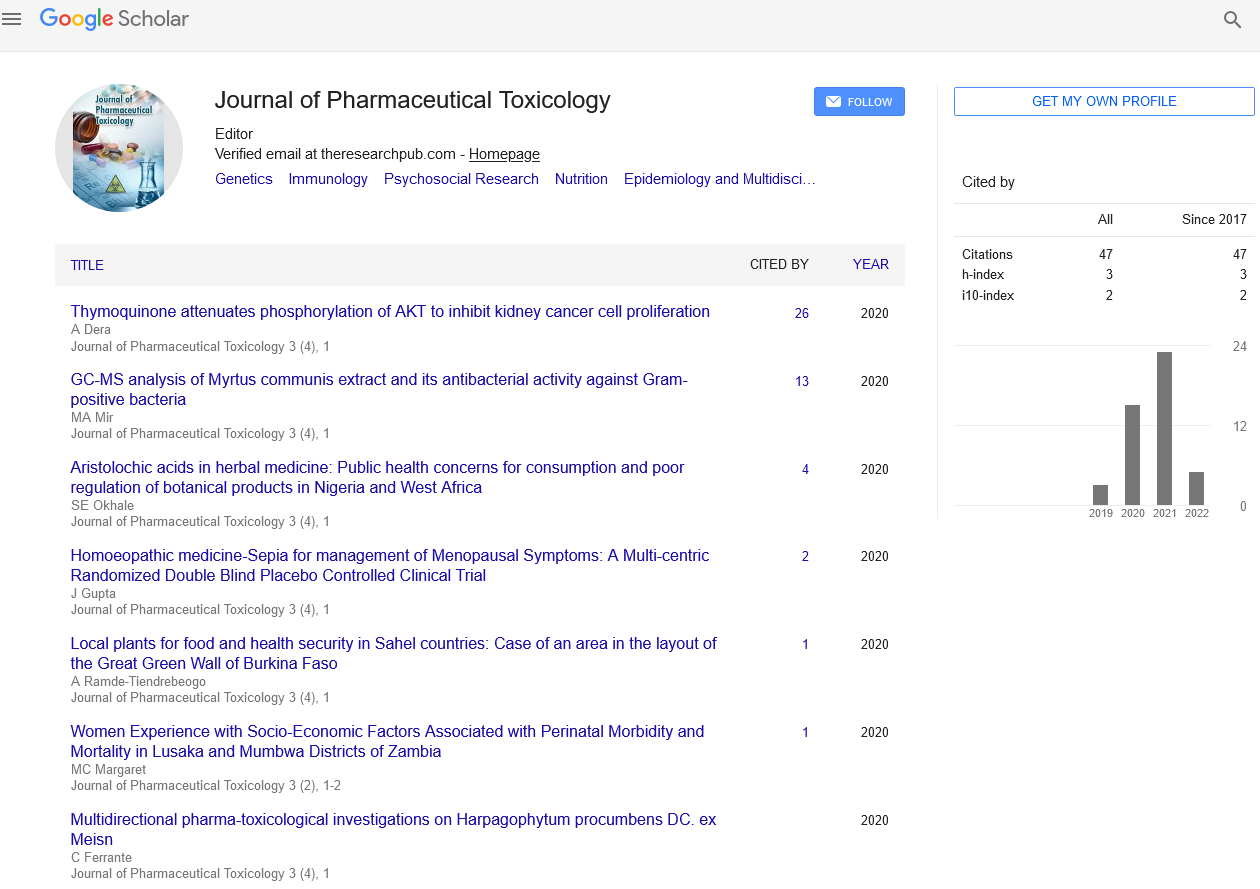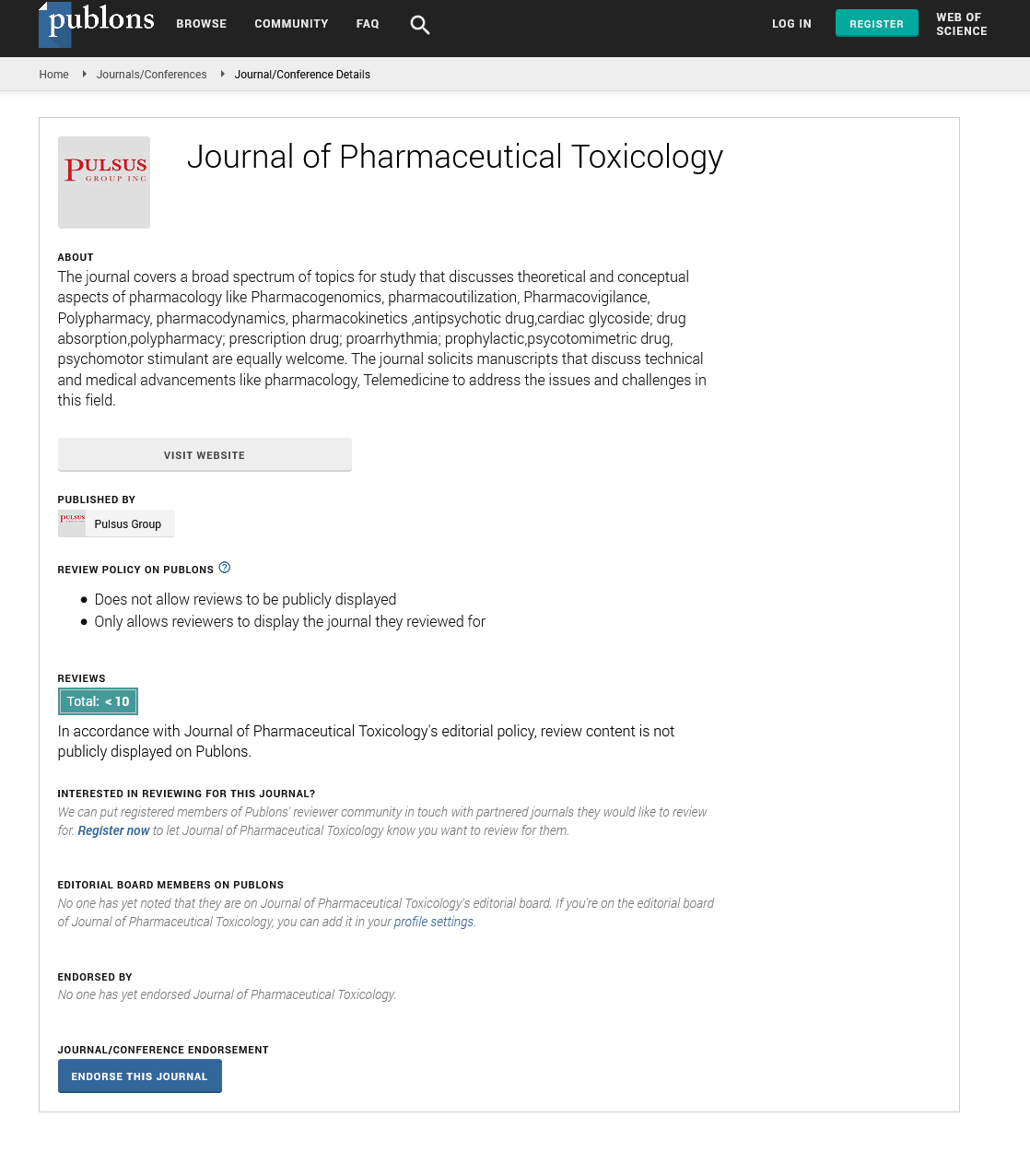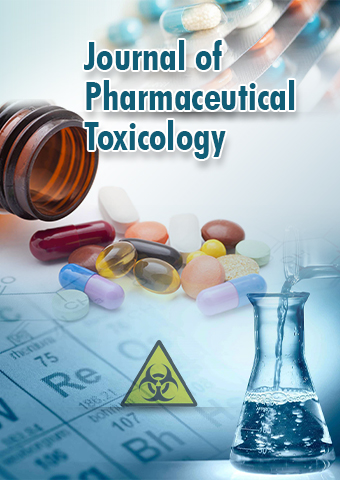Case Report - Journal of Pharmaceutical Toxicology (2023) Volume 6, Issue 4
Pharmaceutical Revolution Lies in the Field of Vaccine Development
Canzian Asan*
Department of Pathology, University of state capital, Australia
Department of Pathology, University of state capital, Australia
E-mail: canzian.asan22@gmail.com
Received: 01-August-2023, Manuscript No. oajpt-23-108569; Editor assigned: 3- August -2023, PreQC No. oajpt-23-108569 (PQ); Reviewed: 17- August -2023, QC No. oajpt-23-108569; Revised: 22- August -2023, Manuscript No. oajpt-23-108569 (R); Published: 28- August -2023; DOI: 10.37532/ jpt.2023.6(4).109-112
Abstract
The pharmaceutical industry has witnessed remarkable progress over the years, revolutionizing healthcare and improving the quality of life for countless individuals worldwide. Through relentless research and development efforts, pharmaceutical companies have consistently produced innovative drugs and therapies, addressing a diverse array of medical conditions and diseases. One of the key driving forces behind the pharmaceutical industry’s success is the integration of cutting-edge technologies and scientific breakthroughs. Recent advancements in areas such as genomics, proteomics, and personalized medicine have paved the way for targeted therapies, tailored to individual patients’ unique genetic makeup. This approach not only enhances treatment efficacy but also reduces adverse effects, making it a pivotal development in modern medicine.
Keywords
Clinical trial • Pharmaceutical • Artificial intelligence • Phase 2 clinical trial • Pharmaceutical industry
Introduction
Artificial intelligence (AI) and machine learning has significantly accelerated drug discovery and development processes. AI algorithms can analyze vast datasets and identify potential drug candidates with greater precision and speed than traditional methods. This has streamlined the drug development pipeline and reduced costs, ultimately making novel therapies more accessible to patients in need. Additionally, the pharmaceutical industry has embraced biotechnology, leading to the rise of biopharmaceuticals. These drugs are produced using living organisms or their components and have exhibited unparalleled therapeutic potential. Monoclonal antibodies, for instance, have revolutionized cancer treatment and immunotherapy, effectively targeting specific molecules involved in disease progression.
Moreover, pharmaceutical companies have made strides in combating infectious diseases, responding to global health challenges such as pandemics. Rapid vaccine development and manufacturing capabilities have played a pivotal role in controlling infectious outbreaks and safeguarding public health. The COVID-19 pandemic served as a catalyst for vaccine innovation, fostering collaboration among scientists and governments worldwide to expedite the deployment of effective vaccines. However, the pharmaceutical industry is not without its challenges. Striking a balance between innovation and affordability remains a pressing issue. High drug prices can limit access for many patients, particularly in low-income regions, necessitating ongoing efforts to ensure equitable distribution of life-saving medications [1,2].
Despite the challenges, the pharmaceutical industry’s commitment to improving healthcare continues to drive progress. With continued investments in research, technology, and collaboration, the future holds promise for even more groundbreaking discoveries and the potential to conquer previously untreatable diseases. The pharmaceutical industry has witnessed unprecedented advancements, transforming the landscape of medicine and healthcare. These groundbreaking developments have revolutionized the way diseases are treated and managed, providing hope to millions of patients worldwide.
One of the most notable breakthroughs is the rise of precision medicine. Gone are the days of one-size-fits-all treatments. With advances in genetics and molecular biology, pharmaceutical researchers have been able to delve deep into the individual genetic makeup of patients. This personalized approach enables doctors to prescribe medications tailored to a patient’s specific One of the most notable breakthroughs is the rise of precision medicine. Gone are the days of one-size-fits-all treatments. With advances in genetics and molecular biology, pharmaceutical researchers have been able to delve deep into the individual genetic makeup of patients. This personalized approach enables doctors to prescribe medications tailored to a patient’s specific
Discussion
Additionally, the advent of biologics has opened up new frontiers in medicine. Biologics are medications derived from living organisms, such as cells, tissues, or proteins. They have shown remarkable success in treating complex diseases like cancer, autoimmune disorders, and rare genetic conditions. As scientists continue to unlock the secrets of biologics, the potential for more targeted and effective therapies seems boundless. Another critical aspect of the pharmaceutical revolution lies in the field of vaccine development. Recent years have seen the rapid creation of vaccines against emerging infectious diseases. Advanced technologies, such as messenger RNA (mRNA) vaccines, have played a crucial role in this endeavor. These innovative vaccines offer a higher level of safety, quicker production, and the potential to combat a wide range of infectious agents effectively.
Moreover, pharmaceutical companies are increasingly focusing on sustainability and environmentally friendly practices. From greener manufacturing processes to eco-friendly packaging, the industry is taking significant strides toward reducing its carbon footprint and minimizing waste. While these advancements hold immense promise, they also come with their challenges. The cost of cutting-edge therapies remains a concern, raising questions about accessibility and affordability for patients worldwide. Moreover, ensuring the ethical use of AI and safeguarding patient data privacy is vital in this technology-driven era [6-8].
In conclusion, the pharmaceutical industry is at the forefront of scientific innovation, transforming healthcare as we know it. With personalized medicine, AI-driven drug discovery, biologics, and groundbreaking vaccines, the future of pharmaceuticals looks brighter than ever. As research continues and collaborative efforts flourish, there is hope that these advancements will bring healing and improved quality of life to countless individuals across the globe. However, addressing ethical, financial, and social challenges will be crucial in ensuring that these groundbreaking treatments reach those who need them most. the pharmaceutical industry has witnessed remarkable progress, revolutionizing healthcare and improving the quality of life for millions worldwide. Thanks to groundbreaking research and cutting-edge technologies, new drugs have been developed to combat various diseases, making significant strides in disease prevention, management, and treatment.
One of the most notable developments in pharmaceutical research is the emergence of precision medicine. This approach tailors medical treatments to an individual’s genetic makeup, lifestyle, and environment. By understanding the unique characteristics of each patient, pharmaceutical companies can create targeted therapies that are more effective and have fewer side effects. Precision medicine has shown promising results in treating cancer, rare genetic disorders, and autoimmune diseases, transforming the way we approach healthcare.
Another area of rapid advancement is biopharmaceuticals, which includes biologics and biosimilars. Biologics are large molecules derived from living organisms and have proven to be highly effective in treating complex diseases like rheumatoid arthritis, multiple sclerosis, and certain types of cancer. Biosimilars, on the other hand, are similar versions of already approved biologics, offering cost-effective alternatives for patients while maintaining comparable efficacy and safety. Furthermore, the utilization of artificial intelligence (AI) and machine learning algorithms has revolutionized drug discovery and development. AI-powered systems can analyze vast amounts of data from clinical trials, genetic databases, and medical records to identify potential drug targets and predict drug candidates’ efficacy and safety. This not only expedites the drug development process but also reduces costs and increases the success rate of bringing new drugs to market.
The ongoing pandemic has also highlighted the importance of vaccine development and distribution. Pharmaceutical companies worldwide collaborated with governments and research institutions to fast-track COVID-19 vaccines. The expedited development process showcased the industry’s adaptability and commitment to public health, resulting in several highly effective vaccines being made available in record time [9,10].
Conclusion
Despite these significant achievements, challenges persist in the pharmaceutical sector. Drug pricing and accessibility remain contentious issues, with concerns about affordability and equity in accessing life-saving medications. Striking a balance between innovation and affordability continues to be a subject of intense debate for policymakers, healthcare providers, and pharmaceutical companies. In conclusion, the pharmaceutical industry has made remarkable strides in drug development and research, transforming the landscape of modern medicine. Precision medicine, biopharmaceuticals, AIdriven drug discovery, and vaccine advancements are just a few examples of the groundbreaking progress achieved. As we move forward, addressing the challenges of drug accessibility and affordability will be crucial in ensuring that these life-changing advancements benefit all individuals, regardless of their socioeconomic background. Through continued innovation, collaboration, and a focus on patient-centric solutions, the pharmaceutical industry can continue to improve healthcare outcomes and contribute to a healthier and more prosperous future for humanity.
References
- Warren KA, Bahrani H, Fox JE et al. NSAIDs in combination therapy for the treatment of chronic pseudophakic cystoid macular edema. Retina. 30, 260-266 (2010).
- Schoenberger SD, Miller DM, Petersen MR et al. Nepafenac for epiretinal membrane surgery. Ophthalmol. 118, 1482-1482 (2011).
- Friedman DS, O’Colmain BJ, Munoz B et al. Prevalence of age-related macular degeneration in the United States. Arch. Ophthalmol. 122, 564-572 (2004).
- Maloney SC, Fernandes BF, Castiglione E et al. Expression of cyclooxygenase-2 in choroidal neovascular membranes from age-related macular degeneration patients. Retina. 29, 176-180 (2009).
- Hu W, Criswell MH, Ottlecz A et al. Oral administration of lumiracoxib reduces choroidal neovascular membrane development in the rat laser-trauma model. Retina. 25, 1054-1064 (2005).
- Chen E, Benz MS, Fish MH et al. Use of nepafenac (Nevanac) in combination with intravitreal anti-VEGF agents in the treatment of recalcitrant exudative macular degeneration requiring monthly injections. Clin Ophthalmol. 4, 1249-1252 (2010).
- Gomi F, Sawa M, Tsujikawa M et al. Topical bromfenac as an adjunctive treatment with intravitreal ranibizumab for exudative age-related macular degeneration. Retina. 32, 1804-1810 (2012).
- Zhou J, Wang S, Xia X et al. Role of intravitreal inflammatory cytokines and angiogenic factors in proliferative diabetic retinopathy. Curr Eye Res. 37, 416-420 (2012).
- Harris R, Beebe-Donk J, Namboodiri KK et al. Inverse association of non-steroidal anti-inflammatory drugs and malignant melanoma among women. Oncol Rep. 8, 655-657 (2001).
- Asgari MM, Maruti SS, White E et al. A large cohort study of Nonsteroidal anti-inflammatory drug use and melanoma incidence. J Natl Cancer Inst. 100, 967-971 (2008).
Google Scholar, Crossref, Indexed at
Google Scholar, Crossref, Indexed at
Google Scholar, Crossref, Indexed at
Google Scholar, Crossref, Indexed at
Google Scholar, Crossref, Indexed at
Google Scholar, Crossref, Indexed at
Google Scholar, Crossref, Indexed at
Google Scholar, Crossref, Indexed at
Google Scholar, Crossref, Indexed at


